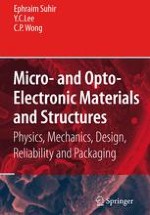2007 | OriginalPaper | Buchkapitel
Durability of Optical Nanostructures: Laser Diode Structures and Packages, A Case Study
verfasst von : Ajay P. Malshe, Jay Narayan
Erschienen in: Micro- and Opto-Electronic Materials and Structures: Physics, Mechanics, Design, Reliability, Packaging
Verlag: Springer US
Aktivieren Sie unsere intelligente Suche, um passende Fachinhalte oder Patente zu finden.
Wählen Sie Textabschnitte aus um mit Künstlicher Intelligenz passenden Patente zu finden. powered by
Markieren Sie Textabschnitte, um KI-gestützt weitere passende Inhalte zu finden. powered by
Durability is a synergistic reliable response of subsystems in integrated (packaged) systems, which in this case under discussion are nanostructured integrated optical systems. Understanding science and engineering aspects of these optical nanostructures integrated systems through design, fabrication, packaging and reliability testing are of paramount importance to obtain durable optical nanostructured packaged systems. To communicate specific aspects, this chapter addresses durability of optical quantum structures through carefully selected case studies in two parts. The part one includes novel design and deposition of quantum structures and the part two includes discussion of reliability of packaged quantum layered laser diode structures.
In the first case study, it is demonstrated that, In
x
Ga
(1−
x
)
N based multiquantum well (MQW) light emitting diodes and lasers (LEDs and LDs) have been fabricated and it is shown that high optical efficiency in these devices is related to thickness variation (TV) of In
x
Ga
(1−
x
)
N active layers. The thickness variation of active layers is found to be as important as In composition fluctuation in quantum confinement of excitons (carriers) in these devices. In this work, MQW In
x
Ga
(1−
x
)
N layers are produced with a periodic thickness variation, which results in periodic fluctuation of bandgap for the quantum confinement of excitons. Detailed STEM-Z contrast analysis, where image contrast is proportional to
Z
2
(
Z
=atomic number), was carried out to investigate the spatial distribution of In. It is discovered that there is periodic variation in thickness of In
x
Ga
(1−
x
)
N layers with two periods, one short range (SR-TV, 30 to 40 Å) and other long-range thickness variation (LR-TV, 500 to 1000 Å). It is envisaged that LR-TV is the key to quantum confinement of the carriers and enhancing the optical efficiency and at the same time offering excellent reliability. The SR-TV is caused by In composition fluctuation. It was also found that the variation in In concentration is considerably less in the LED and LD structures which exhibit high optical efficiency. A comparative microstructural study between high and low optical efficiency MQW structures is presented to show that thickness variation (SR-TV) of In
x
Ga
(1−
x
)
N active layers is the key to their enhancement in optical efficiency.
Once quantum structures are engineered and devices are fabricated packaging and its reliability become important. Hence, in the second case study presented, authors discuss the laser diode package reliability for as applications continue to demand increasingly higher optical output power and longer lifetime, thermo-mechanical stresses on dissimilar materials interfaced for packaging pose an ever-growing challenge for the realization of a durable system. Particularly important for an epitaxy-down configuration is the die-attachment interface, which is desired to be defect-free and stress-managed for reliable optical alignment. A knowledge of the changes in the physical defect density and magnitude of the thermo-mechanical stress present in the active region as a function of the fabrication process and aging is crucial to an understanding of the influence of the process parameters and operating conditions on device performance and reliability. In this case study, we discuss investigation of high power laser diode array packages aged under various conditions. Microscopic defect analyses of the die attachment interface and device stress were carried out using primarily metallography, scanning electron microscopy (SEM), scanning acoustic microscopy (SAM), micro-hardness, and micro-Raman spectroscopy. It was noted that the intermetallic compounds and microscopic physical defects at the die attach interface are detrimental to transient heat transfer, and thus, overall package reliability. Using micro-Raman spectroscopy, we found that tensile stress near the bar-package interface increases with aging for the first few hundred hours and then decreases with further aging.
In conclusion, this chapter discusses synergistic engineering of nano structures along with micro interfaces in a macroscopic packaging which is essential for realizing a durable nanostructured integrated optical system.
